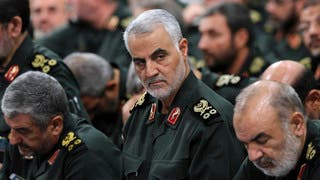
In the wake of the U.S. drone strike that killed Iranian general Qassem Soleimani, the United States faces the issue of what to do with the Popular Mobilization Forces (PMF) of Iraq. The PMF are a veritable deep state in Iraq destabilizing the country and threatening U.S. forces
The PMF includes dozens of Iraqi Shia militias that worked with Qasem Soleimani, the head of the Iranian Quds Force, a branch of the Islamic Revolutionary Guard Corps. Abu Mehdi al Muhandis, a prominent PMF member of the Kata’ib Hezbollah militias was also killed in the attack. Khata’ib Hezbollah, which the US government considers a terror group, vows revenge.
The PMF are deeply embedded in Iraqi society and security structures. They arose during Iraq’s sectarian civil war, beginning in 2006. The PMF killed hundreds of American soldiers and civilians, using explosively formed penetrator devices provided by Iran. The PMF are also responsible for systematic and widespread war crimes against Iraq’s Sunni population.
When the Islamic State invaded Iraq in June 2014, Ayatollah Ali al-Sistani, the most revered Shia cleric in Iraq, issued a fatwa summoning the faithful to defend holy shrines. The PMF played a leading role in the fight to drive ISIS out of Iraq. Along the way, they evolved from a militia into an army — trained, equipped and financed by Iran. The PMF endure, though the caliphate has been defeated.
The Iraqi constitution stipulates that militias are illegal, but the government has been unable to demobilize them. Instead Baghdad has sought to coopt PMF, bringing them under the nominal control of the prime minister’s office and appointing their leaders to government positions.
Iran claims the PMF act independently, outside of its control. While Iran pledged to de-escalate after launching ballistic missiles against US bases in Iraq on January 8, the PMF’s vow of revenge has to be taken seriously.
On January 12, the PMF launched rocket attacks against Balad Air Base that killed four Iraqi servicemen. Though no American trainers were injured at Balad, the attack is a harbinger of future attacks.
PMF leaders such as Falih Alfayyadh (Chairman of Popular Mobilization Committee), Hadi al-Amiri (Commander of the Badr Brigade), Ali al-Yasiri (Khorosan), and Qais al-Khazali (Asa’ib Ahl al-Haq) threaten US forces in Iraq. After Soleimani and Muhandis were killed, Khazali ordered his fighters to prepare for an upcoming battle against the US. He vowed that America’s military presence in Iraq would end soon.
The PMF are proven adversaries targeting US interests, as well as America’s Kurdish allies. For example, Muhandis and other PMF leaders were involved in seizing Kirkuk in October 2017, and trying to kill the pro-American Kirkuk Governor Najmaldin Karim.
After Soleimani’s killing, 170 Iraqi lawmakers approved a resolution asking the Iraqi government to end the agreement under which Washington sent forces to Iraq more than four years ago to help in the fight against ISIS. The resolution barely garnered a majority, with Sunni and Kurdish legislators boycotting the tally. The Trump administration dismissed the vote, concerned that pulling out 5,200 U.S. troops could cripple counter-terrorism efforts and allow the resurgence of ISIS.
Washington’s Options
The United States could withdraw its forces from Iraq. However, President Trump is adamant about maintaining the American military presence, despite the Iraqi parliament’s request that US forces leave the country and demands by Prime Minister Adel Abdul-Mahdi.
The US could ignore the PMF and hope they go away. This is unlikely given their integration into Iraqi security structures and base of popular support with Iraq’s Shia majority.
Washington could urge Baghdad to control the PMF. To date, however, the Iraqi government has shown little willingness or capacity to rein them in.
Not acting is not an option. The leaders of the PMF–Falih Alfayyadh, Hadi al-Amiri, Ali al-Yasiri, and Qais al-Khazali — have been identified as terrorists by the United States. The bombing the Balad Base is the first salvo in a campaign to avenge the killing of Soleimani and Muhandis.
The PMF represent an imminent threat, plotting more attacks to drive the US out of Iraq. Under such circumstances, targeted killings are allowed under international law.
The U.S. government faces a credibility gap, created by President Trump’s claim that Soleimani was killed to prevent an imminent threat. Any future targeted killing must be based on verifiable evidence that an attack is imminent. The after action report should be transparent and detailed.
While some Iraqis would object, Iraq’s Sunnis and Kurds would welcome the removal of Shia extremists, and some Shia politicians would also approve. The removal of Shia extremists would open more space for moderate Shia groups, reducing sectarian polarization. There is no love lost between the PMF and Iraqi politicians, who are struggling to stabilize the country and form a new government.
Iraq can never be secure with the PMF unfettered. Getting rid of the PMF would catalyze an Iraqi-owned process to stabilize the country, enhance national sovereignty, and eventually rid the country of foreign forces. It would also professionalize the Iraqi army, as the first line of defense against violent extremism.
Iraqis resent Iran’s controlling stake in their country. They know the PMF are gangsters who run a parallel state. Iraqis crave stability and effective governance, which cannot be achieved with the PMF at-large.
Phillips is Director of the Program on Peace-building and Rights at Columbia University’s Institute for the Study of Human Rights. He worked on “The Future of Iraq Project” as a Senior Adviser and Foreign Affairs Expert to the State Department during the Bush administration. Phillips is author of Losing Iraq: Inside the Post-WarReconstruction Fiasco.



